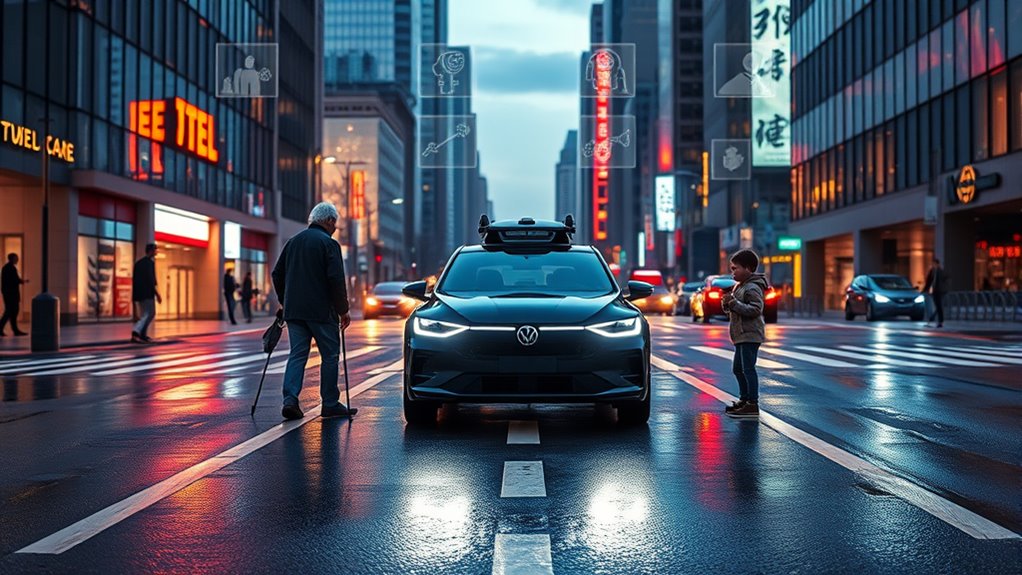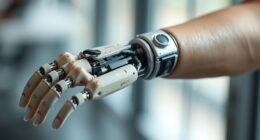In the age of self-driving cars, you’ll face moral dilemmas similar to the trolley problem, where vehicles must make quick decisions that balance different lives. Manufacturers program these cars with ethical algorithms based on various principles, like minimizing harm or prioritizing passengers. These decisions involve complex societal values and raise questions about trust and morality in AI. If you’re curious about how these challenges shape autonomous driving, you’ll find there’s much more to discover.
Key Takeaways
- Self-driving cars face moral dilemmas similar to the trolley problem, requiring programmed ethical decision-making during unavoidable accidents.
- Developers must encode moral algorithms based on societal values, balancing passenger safety against pedestrian risks.
- Ethical frameworks like utilitarianism influence how vehicles prioritize minimizing harm in split-second scenarios.
- Public opinion and legal standards shape the programming of moral algorithms in autonomous vehicles.
- Resolving trolley-like dilemmas is crucial for public trust and the safe, ethical integration of self-driving cars into society.

As self-driving cars become more common, they face complex ethical dilemmas, chief among them being the trolley problem. This dilemma pushes the boundaries of moral algorithms, forcing programmers to decide how a vehicle should act in life-and-death situations. When an unavoidable accident occurs, the car’s decision-making system must weigh different outcomes, often involving difficult choices—such as whether to prioritize the safety of the passengers or pedestrians. These scenarios highlight the profound challenge of coding morality into machines, raising questions about how ethical dilemmas are resolved by artificial intelligence.
Self-driving cars face moral dilemmas like the trolley problem, challenging how machines make life-and-death decisions.
The core issue lies in designing moral algorithms that can handle split-second decisions without human intervention. Developers must determine how a self-driving car interprets these scenarios—should it minimize overall harm, prioritize the lives of its passengers, or follow some other ethical principle? These questions aren’t just theoretical; they have real-world implications. For instance, if a pedestrian suddenly steps into the road, should the car swerve to avoid them at the risk of harming its passengers? Or should it protect its occupants regardless of external factors? The answers depend on the moral framework embedded within the vehicle’s programming, which varies among manufacturers and cultures.
Navigating these ethical dilemmas requires a delicate balance. Some argue that moral algorithms should be based on utilitarian principles, aiming to save the greatest number of lives. Others believe that individual safety, especially of the vehicle’s occupants, should take precedence. But implementing these choices is complicated. It’s not just about programming a set of rules; it’s about understanding the moral values society holds and encoding them into autonomous systems. The challenge is ensuring these systems behave predictably and ethically across diverse situations, without unintended consequences.
Furthermore, the integration of public opinion and legal standards into these moral algorithms plays a crucial role in shaping how self-driving cars make decisions, ensuring they align with societal expectations and laws. As you consider these issues, remember that each decision made by a self-driving car reflects a set of ethical priorities hard-coded into its moral algorithms. These algorithms must be transparent and justifiable, as they will inevitably face real-world ethical dilemmas. The stakes are high: a wrong decision could lead to injury, loss of life, or legal repercussions. The ongoing debate about how best to resolve ethical dilemmas in autonomous vehicles underscores the importance of aligning technological capabilities with societal values. Ultimately, addressing these moral challenges is essential to gaining public trust and ensuring that self-driving cars serve society ethically and safely.
Frequently Asked Questions
How Do Cultural Differences Influence Trolley Problem Moral Decisions?
Cultural morals and societal norms shape how you approach moral decisions, especially in dilemmas like the trolley problem. In some cultures, you might prioritize collective well-being, leading you to accept sacrificing one for many. In others, individual rights take precedence, making you less willing to make such choices. These differences influence your moral judgment, demonstrating that cultural context deeply affects how you evaluate dilemmas and choose actions.
Can AI Algorithms Be Truly Unbiased in Moral Dilemmas?
You might wonder if AI algorithms can be truly unbiased in moral dilemmas. While transparency in algorithms helps you understand their decision-making processes, moral reasoning remains complex and influenced by cultural and societal norms. Despite efforts to make AI fair, complete objectivity is challenging because algorithms learn from human data, which can carry biases. Consequently, achieving full moral impartiality in AI still requires ongoing refinement and careful oversight.
What Legal Liabilities Arise From Autonomous Vehicle Accidents?
Did you know that autonomous vehicle accidents led to over 30,000 insurance claims last year alone? When you’re involved in such an incident, liability distribution becomes complex, often involving manufacturers, software providers, or even owners. Legal liabilities may include product liability, negligence, or breach of duty. You should stay informed, as laws are evolving, and understanding who’s responsible can help protect your rights and clarify insurance claims.
How Do Manufacturers Prioritize Passenger Safety Versus Pedestrian Safety?
You might wonder how manufacturers balance passenger comfort with pedestrian rights. They often prioritize passenger safety to guarantee trust and comfort, but they also implement sensors and algorithms to protect pedestrians. This involves complex programming that weighs risks, sometimes favoring pedestrians in unavoidable situations. Ultimately, they aim to create autonomous vehicles that respect pedestrian rights while maintaining high passenger safety and comfort standards.
Will Public Opinion Shape Future Self-Driving Car Ethical Standards?
Think of public opinion as the compass guiding self-driving car ethics. Your trust influences manufacturers’ decisions, shaping ethical guidelines. When you voice your concerns and preferences, it’s like steering the industry toward safer, fairer choices. As public trust grows, companies are more likely to prioritize transparency and moral responsibility. Ultimately, your opinions help create a moral roadmap that defines how autonomous vehicles handle complex ethical dilemmas.
Conclusion
As you watch self-driving cars navigate tough choices, it’s clear that technology now faces the same moral dilemmas long debated in philosophy. Just like pulling a lever in the trolley problem, these cars must decide who to save—stranger or loved one. Yet, unlike theory, your everyday ride is making these split-second decisions. It’s a reminder that even as machines learn morality, we’re still the ones shaping what’s right and wrong.









